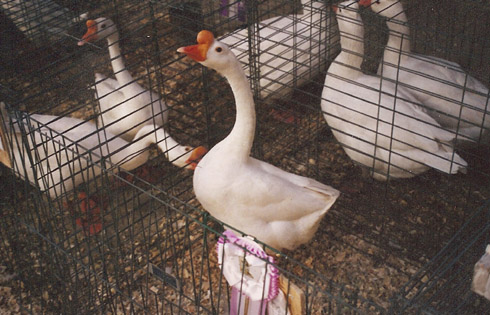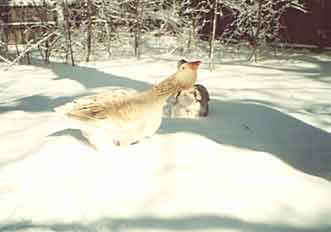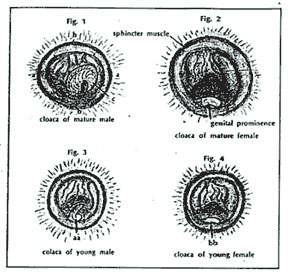This article on sexing geese is being republished from Acorn Hollow Bantams website with permission from Lou Horton.
I get between 20 and 30 emails each week containing questions related to waterfowl. Of that number, the one topic that consistently is the most numerous is the one related to the sexing of geese. Whether the birds were purchased or whether they were raised by their owner, there is frequently a great deal of uncertainty about the sex of some individuals. Unlike ducks, where secondary sexual characteristics make determining the sex of even half grown birds fairly easy even for the beginner, we have no such luck where geese are concerned.

Geese do have some secondary sexual characteristics; it is just that they are much more subtle and prone to exception. Ganders tend to be a bit (sometimes much) bigger and somewhat more upright in their carriage. Their necks tend to be longer and more masculine in thickness. A gander’s head may be bigger and broader than a female’s. Such differences are often easiest to see in Chinas and Africans and more difficult in the European breeds. The problem with applying all of these criteria is that they are subjective and often dependent upon the presence of birds of both sexes to make the comparisons meaningful. If young birds are involved, the age differences can make the comparisons even more confusing.

Once geese reach sexual maturity, the behavioral differences between the sexes makes the task much easier. Ganders tend to be more protective. They will stand between the intruder and their mate and hiss with neck extended, as shown by the below photo. This behavior is much more pronounced just prior to and during the breeding season and may lessen or disappear at other times of the year. Many people feel that the voice of the bird is a good indicator of sexual identity. The normal “talking” voice (not the cry of alarm) of the female tends to be lower pitched than that of the gander. I have found that while that trait is often accurate, it is not universally so because some birds have voices that are “in between” in tone.
Of course, the most sure fire method of determining sex is to observe the birds during the breeding season when the behavior of the birds will be a sure tip off even to the beginner well before the first egg is laid. The other sure fire method is to vent sex the birds. This technique requires turning the bird upside down, arching it’s back, and overting the sexual organs with pressure against the vent supplied by the thumb and index finger. It is best done on birds that are sexually mature and improper vent sexing can cause injury to the sex organ, particularly to a young male. I prefer, therefore, to wait until my birds are sexually mature for that reason although some are so expert that they can vent sex a goose of any age from day old on. I hope that this discussion will be of some help to those faced with the question of the sexing their geese. Just remember that other than observations of actual breeding activity (copulation followed by one member of the pair actually laying fertile eggs) nothing other than vent sexing is 100% accurate. There will always be the exception of the huge and masculine female (a good thing in most breeds when it comes to showing) and the undersized, feminine male (a bad thing in most breeds).
The other sure fire method is to vent sex the birds. This technique requires turning the bird upside down, arching it’s back, and overting the sexual organs with pressure against the vent supplied by the thumb and index finger. It is best done on birds that are sexually mature and improper vent sexing can cause injury to the sex organ, particularly to a young male. I prefer, therefore, to wait until my birds are sexually mature for that reason although some are so expert that they can vent sex a goose of any age from day old on. I hope that this discussion will be of some help to those faced with the question of the sexing their geese. Just remember that other than observations of actual breeding activity (copulation followed by one member of the pair actually laying fertile eggs) nothing other than vent sexing is 100% accurate. There will always be the exception of the huge and masculine female (a good thing in most breeds when it comes to showing) and the undersized, feminine male (a bad thing in most breeds).
By Lou Horton
